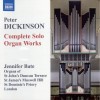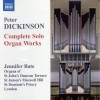Composers
Peter Dickinson (born 15 November 1934) is an English composer, musicologist, author, and pianist,[1] best known for his experimental musical compositions and writings on American music
He was born in Lytham St Annes, Lancashire, and studied organ at Queens' College, Cambridge, where he was a student of Philip Radcliffe.[2] In 1958 he became a student at the Juilliard School in New York City, and studied with Bernard Wagenaar, and encountered the works of experimental composers such as Cowell, Cage, and Edgard Varèse. Returning to England in 1962, he established courses in improvisation and experimental music at the College of St. Mark and St. John, Chelsea. After a lectureship at Birmingham (1966–1970), he became the first professor of music at Keele University in 1974, where he created an important center for the study of American music. He held that position until 1984.[1] He served as chair of music at Goldsmiths College, University of London from 1991 to 1997, and in 1996 became a Fellow and head of music at the Institute of United States Studies in London.
In July 1964 he married Bridget Jane Tomkinson, and they have two sons.[3] As a pianist, he has often performed works by Charles Ives with his sister, mezzo-soprano Meriel Dickinson, reflecting his affinity for that composer. He has also accompanied several acclaimed instrumentalists, such as violinist Ralph Holmes and oboist Sarah Francis. He has also made several international lecture-recital tours.
In 1980 he became a founding member of the Association of Professional Composers and was named a Fellow of the Royal Society of Arts a year later. He has also been a board member of Trinity College of Music since 1984 and a member of the Royal Society of Musicians since 1985.[4] He is also chair of the Bernarr Rainbow Trust, a charity set up in 1997 for the benefit of music education.
His musical compositions include experimental and aleatoric elements, and are compared to works by Stravinsky, Ives and Satie.[2] Other influences include the music of John Cage,[6] as well as ragtime, blues, and jazz.[7] He layers both serious and popular musical styles together to create what he calls a style modulation.[7] The composer explained his interest in combining musical styles: "Ever since hearing live performances of Charles Ives in New York in the late 1950s and first meeting John Cage there, I have been interested in the effect of hearing different types of music simultaneously."[8] His layering is achieved in a different manner to William Bolcom's "aggressively parodic and deconstructive manner", using more of a "genuine warmth of enthusiasm for the material he is exploiting which suggests something closer to a homage.",[6]
His instrumental compositions are for a great variety of musical ensembles, from full orchestra to a single instrument, and there are many keyboard works. He has also composed many songs for solo voice and pieces for various choral ensembles. His modern works for historical instruments are notable. He has composed for better-known historical instruments such as recorder and harpsichord, as well as for less-familiar ones, such as the clavichord and baryton. In contrast to the use of these instruments, he has also added electronic sounds to some works.
Recently Added
| Country: | United Kingdom |
| Period: | Contemporary classical music |
Biography
Peter Dickinson (born 15 November 1934) is an English composer, musicologist, author, and pianist,[1] best known for his experimental musical compositions and writings on American music
He was born in Lytham St Annes, Lancashire, and studied organ at Queens' College, Cambridge, where he was a student of Philip Radcliffe.[2] In 1958 he became a student at the Juilliard School in New York City, and studied with Bernard Wagenaar, and encountered the works of experimental composers such as Cowell, Cage, and Edgard Varèse. Returning to England in 1962, he established courses in improvisation and experimental music at the College of St. Mark and St. John, Chelsea. After a lectureship at Birmingham (1966–1970), he became the first professor of music at Keele University in 1974, where he created an important center for the study of American music. He held that position until 1984.[1] He served as chair of music at Goldsmiths College, University of London from 1991 to 1997, and in 1996 became a Fellow and head of music at the Institute of United States Studies in London.
In July 1964 he married Bridget Jane Tomkinson, and they have two sons.[3] As a pianist, he has often performed works by Charles Ives with his sister, mezzo-soprano Meriel Dickinson, reflecting his affinity for that composer. He has also accompanied several acclaimed instrumentalists, such as violinist Ralph Holmes and oboist Sarah Francis. He has also made several international lecture-recital tours.
In 1980 he became a founding member of the Association of Professional Composers and was named a Fellow of the Royal Society of Arts a year later. He has also been a board member of Trinity College of Music since 1984 and a member of the Royal Society of Musicians since 1985.[4] He is also chair of the Bernarr Rainbow Trust, a charity set up in 1997 for the benefit of music education.
His musical compositions include experimental and aleatoric elements, and are compared to works by Stravinsky, Ives and Satie.[2] Other influences include the music of John Cage,[6] as well as ragtime, blues, and jazz.[7] He layers both serious and popular musical styles together to create what he calls a style modulation.[7] The composer explained his interest in combining musical styles: "Ever since hearing live performances of Charles Ives in New York in the late 1950s and first meeting John Cage there, I have been interested in the effect of hearing different types of music simultaneously."[8] His layering is achieved in a different manner to William Bolcom's "aggressively parodic and deconstructive manner", using more of a "genuine warmth of enthusiasm for the material he is exploiting which suggests something closer to a homage.",[6]
His instrumental compositions are for a great variety of musical ensembles, from full orchestra to a single instrument, and there are many keyboard works. He has also composed many songs for solo voice and pieces for various choral ensembles. His modern works for historical instruments are notable. He has composed for better-known historical instruments such as recorder and harpsichord, as well as for less-familiar ones, such as the clavichord and baryton. In contrast to the use of these instruments, he has also added electronic sounds to some works.




